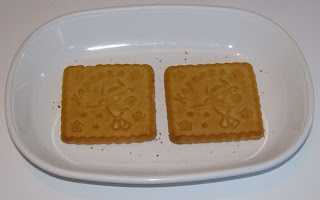Cream is in blue and butter is in yellow, as suits the color of butter.
Back when I first started learning to use computers, I felt completely overwhelmed by the volume of things that I did not know how to accomplish. It may seem inconceivable to people who could use a PC before they could make potty somewhere other than their pants, but I didn't even know how to change the sound. In fact, I recall taking my new black and white Powerbook 145b to work and having a Star Trek screen saver installed that kept making sounds. I went into a pure panic when I couldn't work out how to stop the noises that might alert my Japanese coworkers to the fact that I had my own computer there and that it was playing the equivalent of little sci-fi cartoons when it as idle.
Being confronted with a new language or writing system is a very similar experience. The first sense you get is of being overwhelmed and like you have no footing from which to start working things out. When I first went to Japan, this was the space I lived in and it was daunting. The truth is that it's still daunting given how many kanji (Chinese characters) there are, but I muddled through. Now, I can manage dealing with researching and writing about Japanese snack foods. I'm far from perfect, and some critics might even say far from even "adequate" at it, but I feel like I can stumble around and figure most things out.
Dealing with food that is of a completely different origin puts me back at square one. If I review a Korean snack, I have a sense of flailing around in foreign waters without a life preserver. I know zero about Korean and the same is so about Russian. I don't even know if this is Russian for certain. It may be some other Eastern European language which looks similar, but is totally different. At any rate, I'm trying to swim here, but don't be surprised if I end up failing to even doggy paddle my way through this review. It may end up being the equivalent of "mmm, cookies" and little else given my illiteracy in the language of this product.
I found these cookies at a cool shop that is called "
Crossroads Specialty Foods" in Palo Alto, CA. I was walking around the area near the dealership that was servicing our car, which was having its fluids drained, replaced, or topped off in celebration of its first birthday, when I saw their sign along the street. The sign is kind of weird and not like what it appears to be on the Yelp page that I linked to. It used to have "World Market" written in the middle in big letters and that was simply painted over so there's a big blank in the middle. Also, from outward appearances, it just looks strange because it doesn't have the feel of a market, but rather of a supply store. I approached with caution because I didn't want to walk in and be asked if I wanted help buying 100 lbs. of basmati rice or a drum of olive oil.
That's "cream" on the left and "butter" on the right, but then you could tell by looking, right?
At any rate, after a careful peek through the door revealed shelves full of cookies and candy, I walked in and was greeted to an excellent selection of European and Middle Eastern food and snacks. The selection included a ton of British chocolate as well as Russian cookies and sweets and things like halvah and marzipan. The prices ranged from cheap to reasonable. Since I'm not especially reasonable and quite cheap, I picked up these Russian cookies for a mere 89 cents per 6.3 oz./180 g. packet.
I was intrigued by the fact that the cookies looked absolutely identical, but supposedly were different flavors. Also, I wondered what "cream" flavor was supposed to taste like and if the "butter" flavor would actually taste more buttery. To test this out, I had my husband do a blind taste test to see if he could tell and he could. This was pretty impressive since he doesn't have as keen a sense of taste as I do.
There is a very distinct difference between these cookies, but they are both very good. The butter one has a very discernible butter flavor. In fact, I think it's a fake flavoring since "margarine" is listed as an ingredient, but butter is not. The "cream" version has a cleaner taste, but has a nice plain butter cookie flavor to it overall. Both are "good", but I preferred the cream one.
With all types of plain cookies like these, it's as much about the texture as the taste. These have a great flaky, slightly crumbly texture and they pair extremely well with coffee or tea. They're the type of cookie that is good to have around for guests or times when you just want a little crispy cookie around that's not too sweet.
I really liked these, but I do like butter cookies and fairly simple tasting things that aren't too sweet. Texture is paramount and what I mainly hope for in a cheap consumer-level cookie like this is that it not resemble a cracker. This is absolutely a proper cookie which has a European feel. Is it the end-all and be-all of cookies? It is not, but it's still a pretty nice cookie and I'd definitely buy it again, especially at the price they are currently available.
I checked online for sources of these cookies, and I couldn't find the exact ones online, but there's
an interesting online place for Russian food that sells a variety of these as well as many other products.













































